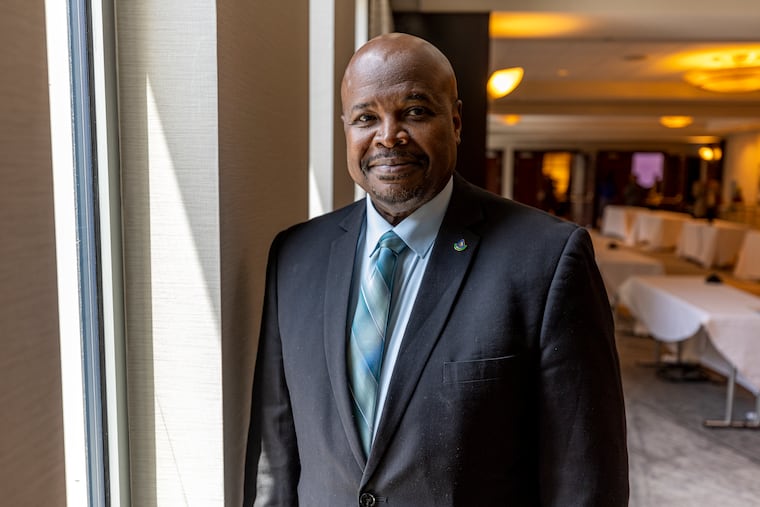Are Philadelphia farmers the key to making the city a cleaner and healthier place to live?
Federal agency is pushing urban agriculture as a climate change and social issues solution.

Farming is not a city story. Urban farming is not an answer to problems facing the city. And farmers aren’t a source of social justice support.
Terry Cosby has spent his life determined to prove that these are wrongheaded views.
As chief of the Natural Resources Conservation Service (NRCS) — an agency of the U.S. Department of Agriculture (USDA) that helps farmers integrate conservation into working lands — Cosby is quietly carrying his message of the relevance of urban agriculture to solve urban problems, starting with NRCS’s 150 national leaders who were in a three-day meeting in Philadelphia that ended July 11.
The agency he works for has little visibility in the city, and Cosby wants to change that. He is insisting his leadership team develop the capability to support urban, indoor, and other emerging agricultural practices associated with city growers, along with their traditional duties.
“I became chief under the Biden-Harris administration, and they asked me from day one about urban agriculture,” Cosby said.
The growth of a movement
Cosby, originally from Mississippi, comes from a long line of farmers. His great-grandfather purchased their family land in the late 1800s, which the family still owns. Cosby believes that no matter how much cement we urban dwellers may trod, we have “farming in our DNA.”
“I’m a rural kid with urban personality,” Cosby joked during a meeting break.
His entire career has been with the NRCS, beginning as an intern in Iowa and becoming chief in 2021. Cosby said he became an urban agriculture advocate after he was posted in Cleveland and met with then-U.S. Rep. Marcia Fudge, a longtime member of the House Agriculture Committee.
Fudge, who has recently retired as secretary of Housing and Urban Development, was looking for solutions to address the gamut of problems her constituents were facing: health, environmental, economic, and violence.
Turning point
That was in the late 2000s, Cosby recalled, and urban agricultural seemed to fit the bill. But it would be a decade before the turning point when the 2018 Farm Bill created new agricultural opportunities in urban communities.
In 2019, following years of advocacy, the city hired Ash Richards, a third-generation farmer, as the city’s urban agriculture director at Philadelphia Parks and Recreation. Richards was to be a voice for urban farmers and a liaison with city government, joining Detroit, Atlanta, Boston and Washington.
In 2022, Agriculture Secretary Tom Vilsack selected 12 members to serve on the USDA’s inaugural Secretary’s Federal Advisory Committee for Urban Agriculture and Innovative Production.
“Urban agriculture has been growing in impact and importance, and we are taking bold actions to build a support structure,” said Vilsack at the time of the announcement. The goal of the advisory committee is to look at how the USDA is supporting urban agriculture, including issues of equity and food and nutrition access.
Philadelphia farmers
Despite the changes at the federal level, Cosby emphasized that it’s essential to have local support for urban agriculture in order for NRCS to effectively do its work. However, agribusiness is more than throwing seeds in the ground, and the economic considerations separate urban gardening from urban agriculture.
Farm Philly is the urban agriculture program of Philadelphia Parks & Recreation. The program began in 2014. It supports 60 agriculture projects on Parks & Rec land. There are also nonprofit farms such as Mills Creek Farm, Sankofa Community Farm, Henry Got Crops CSA, and FarmerJawn.
But it was Greensgrow Farms, which was started in 1997 on a former Superfund site in Kensington by chef and farmer Mary Seton Corboy and her partner Tom Sereduk, that billed itself the nation’s first urban farm. Originally successful, after Corboy died of cancer in 2016 the farm suffered and eventually shut down, showing how difficult maintaining a farm can be and the need for technical and financial support.
» READ MORE: The collapse of Greensgrow, Philly’s nonprofit farm, exposes years of worker allegations
City’s ag plan
Growing From the Root is the city’s plan for building an urban agricultural support system over the next decade and detailing the resources, policies, processes, and programs necessary to sustain urban agriculture. Like Cosby, the plan states that urban agriculture can address hunger by increasing local food production, but also has the ability to build a more just food system and combat the climate crisis.
The NRCS leaders heard a presentation with several urban agriculture experts including the Rev. Carolyn C. Cavaness, pastor of Bethel AME Church of Ardmore, and Dimka Braswell, who owns R and B Farms. The presentation was moderated by Denise Coleman, Pennsylvania state conservationist for the Natural Resources Conservation Service.
It focused on the barriers — especially access to vacant land and critiques of the Philadelphia Land Bank, a decade-old municipal entity charged with managing and selling thousands of city-owned vacant properties.
» READ MORE: After a controversial first decade, what challenges does the Philly Land Bank face now? Five advocates offer advice.
Historic investment in conservation
Money is a resource that will be needed, said panelist Kim Jordan, co-executive director of Philadelphia Orchard Project, especially the ability to pay urban farmers well.
NRCS received almost $20 billion through President Joe Biden’s Inflation Reduction Act for conservation projects that mitigate the climate crisis, the single largest investment in climate and clean energy solutions in American history. Cosby called it a “once-in-a-generation opportunity.”
But the work requires staff. According to NRCS’s most recent strategic plan, the workforce will also have to represent the diversity of the communities it serves with an emphasis on minority women. “We need over 4,000 folks in the next two years,” Cosby said.
For Cosby, who has spent more than 40 years at the agency, there’s a place for city people to make conservation their life’s work.